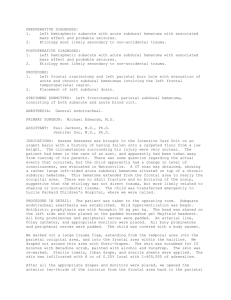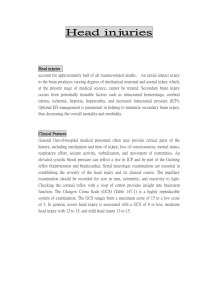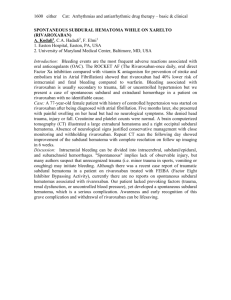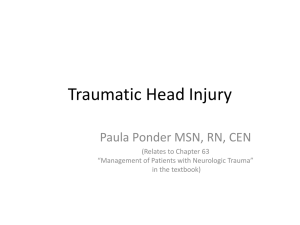Evacuation of a Subdural Hematoma
advertisement
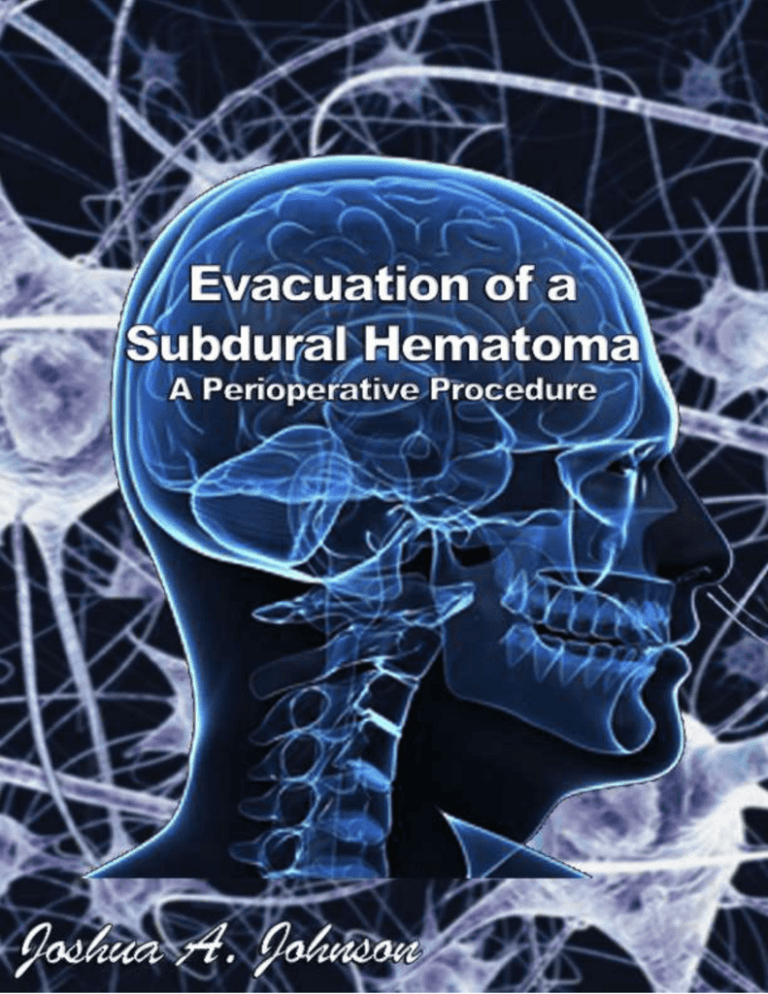
To my brother, who valiantly endured the discussed medical condition, and fortunately evaded the need for surgery. Table of Contents v Table of Contents Contents Table of Contents ............................................................................................................................ v Introduction ................................................................................................................................... vii History....................................................................................................................................... vii Chapter One: ................................................................................................................................. 9 Chapter One - Neurosurgical Instruments .................................................................................... 11 Chapter Two: .............................................................................................................................. 17 Chapter Two – Preoperative Phase ............................................................................................... 19 Procedural Information ............................................................................................................. 19 Acute Subdural Hematoma ................................................................................................... 19 Subacute Subdural Hematoma .............................................................................................. 19 Chronic Subdural Hematoma ................................................................................................ 19 Evacuation Technique - Burr Hole ....................................................................................... 20 Evacuation Technique - Craniotomy .................................................................................... 20 Chapter Three: ............................................................................................................................ 21 Chapter Three – Intraoperative Phase ........................................................................................... 23 Incisions .................................................................................................................................... 23 Occlusion .................................................................................................................................. 24 Chapter Four:.............................................................................................................................. 27 Chapter Four – Postoperative Phase ............................................................................................. 29 Recovery ................................................................................................................................... 29 Preparing for Discharge – Intensive Care Unit ..................................................................... 29 Discharge Instructions .......................................................................................................... 29 Works Cited .................................................................................................................................. 33 Text Sources.............................................................................................................................. 33 Neurosurgical Tools Sources .................................................................................................... 34 Picture Sources.......................................................................................................................... 35 Introduction vii Introduction The brain injury discussed in this instruction manual is called a subdural hematoma. A subdural hematoma occurs when a blood vessel is ruptured beneath the dura mater1, thus causing a collection of blood to accumulate within the restricted confines of the skull. As you can imagine, the pressure of blood against the skull forces brain to mutate. If left untreated, the increase of blood could result in death. The purpose of this instruction manual is to provide an accessible explanation of a neurosurgical phenomenon to pre-medical undergraduate students. In other words, pre-med students could acquire an insight into their future while better preparing for medical school. At no point should this procedure be attempted without a license to practice medicine, as it takes years of rigorous training to acquire the knowledge to properly execute. History Dating as far back as 9,000 years ago, brain surgery is arguably the most ancient practiced medical art (Siegfried). Then, such an art was new so drilling into the heads of others using barbaric methods was considered normal. Reasons for this treatment consisted of headaches, mental illness, head injuries, and even a broken heart (Webb). While a broken heart would have resulted in operation then, it takes quite a bit more convincing now. Today, magnetic resonance imaging, or MRI’s, are used to detect subdural hematomas. Modern brain surgery takes ancient methods and combines them with state-of-the-art technology to produce the most advanced surgical procedures known to man. Now, the art of penetrating the skull for surgery is termed trepanation, and it accounts for an estimated 500,000 yearly visits to the hospital for patients with a brain injury. Sadly, merely 360,000 of such surgeries are successful (The Center for Head Injury Services). On the bright side, the evolution of time yields greater technology, lower death rates, and a deeper understanding of the human brain. 1. Dura Mater (also, dura): A thick membrane that encloses the brain and spinal cord. The dura rests beneath the skull. Chapter One: Neurosurgical Instruments Chapter One – Neurosurgical Instruments 11 Chapter One - Neurosurgical Instruments The following is a depiction of the instruments required for the surgery in addition to a brief explanation: Small Weitlaner Retractor: Periosteal Elevator: This is used to hold open the surgical site. An instrument used to clear tissue form the surgical site. Surgical Aspirator: Electrosurgical Pencil: A source of suction to rid the surgical site of excess blood. A heating tool used to cauterize1 and establish hemostasis2 at the surgical sites 1. Cauterize: To burn (a portion of tissue) for the purpose of ceasing blood flow at the surgical site. 2. Hemostasis: Occurs when blood ceases to flow at a surgical site for a clear field of view. 12 Evacuation of a Subdural Hematoma Irrigation Bottle: 3-0 Vicryl Stitching: A solution bottle used to cleanse the surgical site. A stitching used to re-connect tissue. Burr Hole Cover: Bone Wax: A cap to cover and protect the trepanation site. A wax used to acquire hemostasis and soften the trepanation site. Chapter One – Neurosurgical Instruments 13 Surgical Towels: Iodine Dressing: Surgical “blankets” to cover and keep clean the areas outside of the surgical site. An iodine solution for preparation of the surgical site and prevention of infections. Irrigation Instrument: Forceps: A water source to provide irrigation to the surgical site when necessary. An instrument used to remove excess tissue. 14 Evacuation of a Subdural Hematoma Ioban: Drape Sheets: An iodine sheet placed on the surgical site to prevent contamination. Sheets that capture blood irrigated from the surgical site. Bacitracin Ointment: Surgical Knife: This will be used to prevent the growth of bacteria at the surgical site ( Drugs and Medications - Bacitracin top) An instrument used to create incisions. Chapter One – Neurosurgical Instruments Surgical Drill: A high-speed drill that is used to create burr holes 15 Chapter Two: Preoperative Phase Chapter Two – Preoperative Phase 19 Chapter Two – Preoperative Phase Procedural Information At this point, the patient/family should be fully aware of what the surgery consists of, including costs, risks, and other factors. 1. To start, the physician informs the family or patient of the costs involved in the surgery. Typically, the surgery for the removal of a subdural hematoma costs as much as approximately $50,000 (Kalanithi). Despite the high cost of the procedure, the patient is strongly recommended to continue the surgery, as a patient’s life exceeds material worth. 2. Second, the physician briefly explains the risks of the procedure. There are two categories of risks involved: That from the anesthesia, and that from the surgery itself. Risks from the anesthesia can include heart attacks, blood clots, and undesirable reactions. From the surgery itself, risks may include failure of the scalp to heal, brain injury, excessive bleeding, stroke, paralysis, and even death (Neuro Surgery PA). 3. The patient/family is then educated about what subdural hematoma is as well as the causes and other characteristics. There are three types of subdural hematomas: acute, subacute, and chronic. Acute Subdural Hematoma An acute subdural hematoma is characterized by an immediate accumulation of blood following a severe injury (vehicle accidents, falls, physical assaults, etc.). Due to both the severity of the condition and high risk of death, the patient should be immediately transported to a medical facility. The result of this condition may pose permanent physical disabilities as well as impaired mental functioning; as a result, the postoperative phase is generally long term (NHS Choices). Subacute Subdural Hematoma A subacute subdural hematoma (SSH) is similar to an acute subdural hematoma in regards to severity; however, detection of an SSH is generally delayed by days, and even weeks post-injury. Few incidents resulting in this condition have been recorded, therefore, little information is known (NHS Choices). Chronic Subdural Hematoma A chronic subdural hematoma occurs when a gradual accumulation of blood coagulates1 throughout the duration of two to three weeks post-injury. Conditions are less fatal than that of an acute subdural hematoma; however, surgery is often required (NHS Choices). 20 Evacuation of a Subdural Hematoma 1. Coagulate: A clot (of blood) Additionally, evacuation techniques will vary in consideration of the quality of the injury, but generally, there are two techniques used: through a burr hole, and through a craniotomy. Evacuation Technique - Burr Hole The burr hole technique is a form of trepanation that consists of drilling two holes in the patient’s skull. One burr hole (at the anterior location1) is inundating with an irrigation bottle, while the other (at the posterior location2) is the exiting site of the fluid. This is the technique discussed in this instruction manual. Another form of this technique involves drilling one small hole followed by inserting a suction tube. The suction tube will drain blood from the subdural space. The burr hole technique is among the least evasive and is therefore one of most used for chronic subdural hematomas (NHS Choices). Evacuation Technique - Craniotomy Evacuation through a craniotomy consists of the removing a portion of the skull. The large clot of blood is removed via suction and irrigation. A craniotomy is more evasive than evacuation through a burr hole and is therefore only used in severe cases such as acute subdural hematomas and some chronic subdual hematoma. The portion of the skull removed depends on case characteristics (NHS Choices). It should be noted that not all subdural hematomas require surgery, as it is strongly determined by the severity of the case. Characteristics of the subdural hematoma vary in consideration of the type, but generally symptoms may include (but not limited to): dizziness, vomiting, mental confusion, coma, obstruction of eyesight or other physical motions (NHS Choices). Following the disclosure of information regarding a subdural hematoma, the patient is draped and prepared for surgery. 1. 2. Anterior location: An anatomical location representing the front portion of the human body. Posterior location: An anatomical location representing the back portion of the human body. Chapter Three: Intraoperative Phase Chapter Three – Intraoperative Phase 23 Chapter Three – Intraoperative Phase To begin, the patient is rested in a supine position, with his/her head lifted on a cerebellar headrest. The patient is then given perioperative1 antibiotics to prevent harmful bacteria from infecting the surgical areas. Once administered, the patient is anesthetized. The surgery begins. Note: The location of incisions is made in accordance to the characteristics of the patient’s injury; however, much of the procedures follow a general pattern. Supine Position Incisions In this section, two linear incisions will be marked. The first is 2-3cm (in length) marked 12cm above the superior temporal line. This mark will be located just before the hairline. The second linear mark will also be 2-3cm in length, but located just behind the patients ear and lateral to that of the first incision mark. The area of the incision marks is then shaved. A shave will provide a clear viewing field for the Superior Temporal Line neurosurgeon, as well as a sanitary environment for the patient. Once shaved, the surgical areas are dressed in iodine to kill harmful bacteria. Surgical towels are placed to surround the sites with Ioban, and blood sheets placed above, respectively. Along both marks, linear incisions are made down to the patient’s skull. A periosteal elevator is used to clear the surrounding tissue while a weitlaner retractor is used to push the tissue clear from the surgical area. Hemostasis is obtained through cauterization of the site, which is accomplished with the use of an electrosurgical pencil. The neurosurgeon then creates a burr hole using a high speed perforating drill. During which, both a gentle irrigation and aspiration are applied to cleanse the site. Bone wax is then applied to achieve intracranial hemostasis2 in addition to softening the site of trepanation This may also prevent small particles of cranial bone from entering the burr hole and damaging the brain. 1. Perioperative: A term representing the entire timeframe surrounding the operation. 2. Intracranial Hemostasis: A type of hemostasis that occurs within the skull; the ceasing of blood flow in the skull. 24 Evacuation of a Subdural Hematoma The same sequence of events is then completed at the posterior location After meticulous hemostasis1 is acquired at both surgical sites, penetration of the dura is commenced in a cruciate manner starting at the anterior location. At this point, partial evacuation of the subdural hematoma is executed with the use of a surgical vacuum drain. Attention is then turned to the posterior location, where the same method of penetration is implemented. Once both surgical sites are fully accessible, complete evacuation can occur. This is accomplished with the combination of irrigation at the anterior site, and suction at the posterior site. Figure 1.1 illustrates. Evacuation Note: Extra caution must be taken during this process, as the patient’s brain is visible at this point. Any damages to the brain may result in catastrophe. Any excess membranes that are unattached within the subdural space should be removed during evacuation, as they contribute to clotting in the subdural space. Figure 1.1 As the evacuation proceeds, it may be noticed that the irrigation exiting the posterior location is clear; at which point indicates that the evacuation of the subdural hematoma is complete. Once the subdural hematoma is fully evacuated, occlusion of both burr holes may commence. Occlusion At this point in the procedure, both surgical sites should be at a state of meticulous hemostasis. If so, final irrigation of both burr holes should fill the subdural space. Burr hole covers are then applied to both sites and secured appropriately. This will protect the brain from small objects entering the skull. Once secured, a subgaleal drain2 is inserted over each site, starting at the anterior location, and terminating at the posterior location. This will ensure complete fluid evacuation at a subgaleal level. Burr Hole Covers 1. Meticulous Hemostasis: A form of hemostasis that involves ceasing blood flow in all vessels of the surgical locations. 2. Subgaleal Drain: A tubing that is inserted below the galeal tissue. Chapter Three – Intraoperative Phase 25 In order to eliminate devitalized tissue and small particles, a gentle irrigation is applied to both sites once more. A thorough irrigation will prevent extracranial infections in the tissue; therefore, it is crucial to adequately execute this step. Once completed, 3-0 Vicryl stitches are used to rejoin the scalp tissue. The stitches will penetrate the tissue to the subgaleal level and occlude the burr hole covers. The final occlusion process of stapling the exposed scalp edges together is carried out. The inserted staples will secure the tissue while preventing dehiscence. Finally, Bacitracin Ointment is applied to each site. Bacitracin Ointment is an antibiotic used to cease the growth of bacteria, and thus, prevent infections. After the sites are properly dressed with the antibiotic, the combination of gauze pads and an adhesive border covers the wound. Gauze pads will prevent bleeding while protecting the sites, and the adhesive border will hold the gauze pads to the skin surface. After the wound is appropriately dressed and bandaged, the patient is transferred to ICU where he/she will be monitored for the next three days (at minimum). Source: https://www.youtube.com/watch?v=jD3JTOaS20&list=PLu7E6jGn089z_ielY_qmuTJd0CFFmJR1h&index=12 Chapter Four: Postoperative Phase Chapter Four – Postoperative Phase 29 Chapter Four – Postoperative Phase Recovery Following the operative stage, the patient is transferred to the Post-Anesthesia Care Unit (PACU), or most commonly referred to as, the Recovery Room. The patient will spend one to two hours in this unit for periodic monitoring of blood pressure, neurological functions, temperature, pulse, and respirations (Giecer). Preparing for Discharge – Intensive Care Unit Once the time spent in the recovery room has expired, the patient is transferred to the Intensive Care Unit (ICU). Duration of time spent in the ICU depends strongly on the severity of the conditions and type of hematoma that was evacuated. Characteristics of the patient’s stay in ICU are as follows: Pain medicine is administered as needed by injection, and later by mouth as the patient is more active. Limited consumption of food and liquid is permitted only after the patient has been awake for some time. Urine is collected through a catheter1 whereafter it is drained. The catheter is removed as soon as the patient has gained independence. Constipation occasionally follows such as surgery; therefore, stool softeners are administered as needed. Characteristics of the patient’s stay in ICU will differ with every person; as a result, more or even less characteristics may be considered (Giecer). Once the patient is well enough to be released, he/she is discharged. Discharge Instructions Upon discharge, the patient should be informed of instructions regarding the development of negative symptoms after the surgery has taken place. In some cases, the patient may be recommended various types of therapy depending on the characteristics of postoperative symptoms (NHS Choices). Postoperative symptoms may include the following: Confused speech, headache, seizures, weakness in the limbs, nausea, vomiting, numbness, etc. (Medline Plus). 1. Catheter: A thin tube inserted into the patient’s bladder to remove urine. 30 Evacuation of a Subdural Hematoma The patient’s day-to-day activity may be limited until otherwise authorized by a physician. Limitations and additional instruction may include the following: Plenty of rest. In other words, the patient should avoid any athletic activities, especially those of which may risk an additional injury to the head. It is imperative that the patient gives his/her injury time to heal. A plastic wrap should be placed over the patient’s injury site prior to showering. The plastic wrap should be removed afterwards and the dressing should be changed immediately. Following a week after the surgery and when the stitches have been removed, the patient may shower without a covering plastic wrap. The development of swelling, redness, dehiscence1 or irrigation of the wound must be immediately reported to the appropriate physician. Temperature should be taken daily at 4:00 PM and if it exceeds 101 degrees Fahrenheit (38 degrees Celsius) the appropriate physician should be contacted. In the case of a seizure, the patient should be immediately transported to the emergency room or a physician should be contacted. The patient is permitted sexual activity granted it does not disturb the injury site. Any new or unusual developing symptoms should be reported to the appropriate medical office. Prescribed medications should be taken as instructed by the patient’s physician. Driving is prohibited unless otherwise later authorized by the patient’s physician. Follow-up appointments may be established during the recovery phase and the patient should be apt to attend. These appointments are made to ensure full recovery of the patient; therefore, instructions regarding these should be followed (Neuro Surgery PA ). It is important to note that full physical and cognitive recovery may take years depending on operative complications and severity of the injury. In some cases, symptoms may be permanent, such as fluctuations of the patient’s mood, inability to recollect various events, distorted concentration, and feebleness in the patient’s limbs (NHS Choices). 1. Dehiscence: The rupture of a surgically occluded wound. Chapter Four – Postoperative Phase 31 Full recovery time depends solely on the severity of the condition, but several weeks should yield positive results granted that the patient follows instructions. An office phone number and/or email may be provided for any questions or concerns that the patient may have. Work Cited 33 Works Cited Text Sources Drugs and Medications - Bacitracin top. 2014 йил 8-April <http://www.webmd.com/drugs/drug14270-bacitracin+top.aspx >. Giecer, Michael. “Burr Holes and Craniotomy.” Neurosurgical Consultant. 2014 йил 8-April <http://www.neurosurgical-consult.com/Burr_Holes_Craniotomy_Patient_Instructions.pdf>. Kalanithi. Hospital costs, incidence, and inhospital mortality rates of traumatic subdural hematoma in the United States. 2011 йил November. 2014 йил 8-April <http://www.ncbi.nlm.nih.gov/pubmed/21819196>. Medline Plus. Subdural Hematoma. 2014 йил 8-April <http://www.nlm.nih.gov/medlineplus/ency/article/000713.htm>. Neuro Surgery PA . Burr Hole: Subdural Hematoma. 2014 йил 8-April <http://www.neurosurgerypa.com/procedures/Burrhole.html>. Neuro Surgery PA. Burr Hole: Subdrual Hematoma. 2014 йил 8-April <http://www.neurosurgerypa.com/procedures/Burrhole.html>. NHS Choices. Subdural Haematoma - Recovery. 2014 йил 8-April <http://www.nhs.uk/Conditions/Subdural-haematoma/Pages/Recovery.aspx>. —. Subdural Haematoma - Treatment. 2014 йил 2014-April <http://www.nhs.uk/Conditions/Subdural-haematoma/Pages/Treatment.aspx>. —. Subdural Haematoma: Introduction. 2014 йил 8-April <http://www.nhs.uk/conditions/subdural-haematoma/Pages/Introduction.aspx>. Siegfried, Juliette. History of Bain Surgery. 2014 йил 8-April <http://www.brainsurgery.com/history-of-brain-surgery-1/>. The Center for Head Injury Services. 2014 йил 8-April <http://www.headinjuryctrstl.org/statistics.html >. Webb, Sam. Anceint Peruvias Carried Out Brain Surgery. 2013 йил 2013-December . 2014 йил 2014-April <http://www.dailymail.co.uk/sciencetech/article-2526979/Ancient-Peruvians-carriedBRAIN-SURGERY-Macabre-practice-used-treat-head-injuries-broken-heart.html>. 34 Evacuation of a Subdural Hematoma Neurosurgical Tools Sources http://img.hisupplier.com/var/userImages/2008-06/25/china-implants_161538.jpg https://www.stryker.com/enus/products/Instruments/GeneralMultiSpecialtyInstruments/SonopetUltrasonicAspirator/g roups/public/documents/web_prod/da_141515.jpg http://ecx.images-amazon.com/images/I/31OtWej6Y7L._SX300_.jpg http://www.gypsytreasure.com/images/BONEWAX%20NEW%200912.jpg http://img.tradekey.com/p-8092956-20130708063338/electrosurgical-pencil.jpg http://extww02a.cardinal.com/us/en/distributedproducts/images/M/M6640EZ.jpg http://www.innomed.net/Images/prod_shots_430/ChungWeitlander.jpg http://www.acesurgical.com/media/catalog/product/cache/1/image/9df78eab33525d08d6e 5fb8d27136e95/0/3/0300022_01_13.jpg http://media.benersättning.se/2012/05/vicryl1.jpg http://www.clinicalhealthservices.com/images/products/detail/DrapeSheets40x28.jpg http://di33.shoppingshadow.com/pi/i.ebayimg.com/00/$T2eC16dHJHQFFhiC9KtVBR)rzqZ9Mg~ ~_32-500x500-0-0.JPG http://www.google.com/url?sa=i&rct=j&q=&esrc=s&source=images&cd=&docid=LcdBt MpuAYumlM&tbnid=xJwKTzS0qzNQVM:&ved=0CAIQjBw&url=http%3A%2F%2F3. imimg.com%2Fdata3%2FDQ%2FUF%2FMY-6068310%2Fsurgical-knives250x250.jpg&ei=IME0UbkBce_sQSG9YG4Dw&bvm=bv.63808443,d.b2I&psig=AFQjCNHPiia8KuBTrTPuyn7 RNYLIHJDedQ&ust=1396052637526957 http://www.clovermedical.net/orthopedics%20surgical/economy%20bone%20drill.jpg http://ecx.images-amazon.com/images/I/71Cw2SracLL._SL1500_.jpg http://unimedms.com/images/picresized_th_1291662827_Dynarex-1426.jpg http://www.indiamart.com/golden-india-surgicals/trocars-cannulas-needles.html http://www.hnmmedical.com/media/catalog/product/cache/1/image/9df78eab33525d08d6 e5fb8d27136e95/6/1/61-cushing-debakey_tissue_forceps.jpg http://zh.medwow.com/med/surgical_power_tool/sodem_systems/universal_power_syste m/xuniversal-power-system.mth33649_200_200.jpg.pagespeed.ic._sMdJ-sVPP.jpg http://www.bigmedicalstore.com/images/products/2217.JPG Work Cited 35 Picture Sources http://health.shorehealth.org/graphics/images/en/9453.jpg http://upload.wikimedia.org/wikipedia/commons/5/55/Hieronymus_Bosch_053_detail.jp g http://2.bp.blogspot.com/ffMAf32DvIE/UiWIbK0uoOI/AAAAAAAAESo/NBGOQPuposY/s640/BrainNeurons2.jpg http://static.guim.co.uk/sysimages/Guardian/Pix/pictures/2013/3/1/1362160039369/human-brain-x-ray-008.jpg http://www.eschmann.co.uk/assets/Uploads/ProductImages/032-T10-Skull-ClampSupine.jpg http://www.pegym.com/wp-content/uploads/2013/11/erectile-dysfunction-diagnosing.jpg http://cell2soul.typepad.com/.a/6a00d83452a3b369e20133f58f8d4e970b-800wi http://www.yorkhospital.com/uploads/PACU-cv.jpg http://img.webmd.com/dtmcms/live/webmd/consumer_assets/site_images/articles/health_ tools/dry_mouth_causes/getty_rf_photo_of_man_talking_to_doctor.jpg http://i1.ytimg.com/vi/yOeR5cmxyZ4/hqdefault.jpg http://i3.ytimg.com/vi/R0dhzZekiis/mqdefault.jpg http://blog.emcare.com/Portals/158207/images/Patient%20Discharge.jpg http://www.ucdenver.edu/academics/colleges/medicalschool/departments/Neurosurgery/p atientcare/PublishingImages/Appointment_Time_253097.jpg http://www.azdhs.gov/diro/borderhealth/bids/images/thermometer.jpg Work Cited 37
